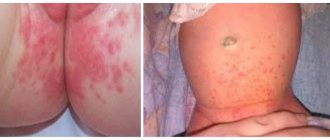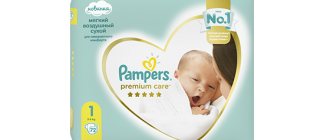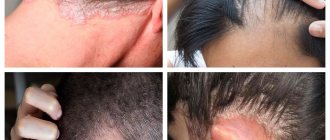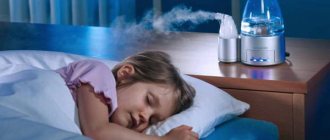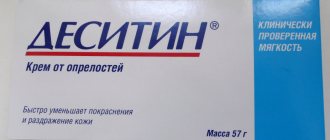About the disease
Diaper rash is irritation of the baby's delicate skin due to mechanical friction or secretions (urine, feces).
The skin often suffers in natural folds (perineum and under the arms). Inflammation primarily occurs without infection, especially with a change in diet, which changes the properties of feces. However, due to the nature of children's skin, a bacterial or fungal infection can quickly develop, requiring immediate treatment. Diaper rash most often occurs in girls and boys who are bottle-fed, who are overweight, who have digestive disorders, who are prone to allergies, who have lactase deficiency, or abnormal kidney development. Excessive wrapping, high room temperature, untimely bathing, prolonged stay in wet diapers or a diaper of the wrong size contribute to the development of diaper rash.
Diaper rash usually occurs as a result of:
- excessive sweating. Due to the fact that some mothers are afraid of colds and hypothermia, they wrap their babies like cabbage. As a result, the child’s skin does not breathe at all, and sweat appears in its folds, which leads to inflammation.
- untimely hygiene. Newborns defecate very often. Uric acid itself causes irritation, and when combined with feces it forms ammonia, which can damage the skin many times more.
- mechanical impact. This could be a diaper that is not put on correctly, clothes made of synthetic fabrics or with tight seams, or uncomfortable underwear.
- high humidity. Most often, this situation occurs when the baby is not wiped dry after bathing. Water remains in the folds of the skin and causes irritation. Diaper rash on the neck of a baby often appears for this very reason.
- allergies. Usually it comes in 2 types: food. If the baby is breastfed, then allergies can be caused by changes in the mother's diet. In addition, skin irritation is often provoked by foods that the baby first tries when complementary feeding begins.
- contact This may be a reaction to the chemical composition of washing powder, hygiene products or diapers.
Classification of diaper rash in a child
Experts identify several types of skin diaper rash in children , which largely determine the choice of treatment for the pathology:
- diaper dermatitis - redness and rash appear only in those places that are constantly in contact with wet diapers;
- allergic ring - occurs around the anus due to a food allergy that develops to a new food product;
- seborrheic eczema - the skin of the lower abdomen and genitals becomes rough, swollen, oily to the touch, the border with normal skin is clear, looks like a hyperemic (bright red) huge spot;
- intertrigo - affects natural folds (gluteal, elbow, popliteal and others), against the background of redness, weeping cracks form, this condition is provoked by increased humidity;
- genital candidomycosis - occurs when a fungal infection is attached, has the appearance of red spotty rashes;
- impetigo - occurs when a pyogenic infection occurs; it first appears as separate and then small draining ulcers, which form crusts after drying. Impetigo in children forms on the buttocks.
Types of vulvovaginitis in girls
- Specific infectious vulvovaginitis occurs when contaminated with pathogenic microflora - Trichomonas, chlamydia, gonococci, etc.
- Nonspecific infectious vulvovaginitis is caused by excessive growth of opportunistic microflora - staphylococci, streptococci, etc.
- Primary vulvovaginitis can be caused by infection due to the penetration of a foreign body, as a result of helminthic infestation, or infection with nonspecific microorganisms.
- Secondary inflammation occurs against the background of other diseases - endocrine disorders, pathologies of the genitourinary system, viral diseases, atopic dermatitis, etc.
Vulvovaginitis varies depending on the pathological agent that caused the inflammation. Among the pathogens are Trichomonas, chlamydia, Koch's bacillus, as well as viruses, fungi, etc.
The most common pathologies:
- Trichomonas vulvovaginitis. Caused by Trichomonas. It can be transmitted to a newborn girl from the mother during childbirth, as well as in girls over 12 years of age. It is characterized by foamy discharge with an unpleasant odor, severe itching and swelling of the mucous membranes.
- Mycotic vulvovaginitis. The cause is yeast-like fungi. Diagnosed in newborns and girls over 12 years of age. It is characterized by severe itching and the appearance of white, curd-like discharge.
- Viral vulvovaginitis. The cause of inflammation is viral infections - measles, rubella, ARVI, characterized by mild redness and swelling of the mucous membranes.
In terms of duration, the disease can be acute (lasting up to 3–4 weeks), subacute (lasting from 1 to 3 months) and chronic, lasting from 3 months or more.
Degrees and symptoms of diaper rash in a child
There are three degrees of severity of diaper rash in children, each of which is characterized by specific symptoms:
- Grade 1: mild damage, in which small areas of redness are found on the skin;
- 2nd degree: moderate damage, characterized by the appearance of bright red erosions with a large number of small cracks, less often pustules;
- 3rd degree: severe and extensive skin damage with the formation of constantly weeping cracks, the appearance of blisters, erosions and ulcers; in this case, there is a high risk of infectious complications.
The baby's behavior with first-degree diaper rash does not change in any way; skin damage is detected when changing diapers. In the second degree, the child is bothered by burning, pain and itching, which is manifested by tearfulness, moodiness, anxiety, and poor sleep. The addition of a bacterial infection is manifested by an increase in body temperature, loss of appetite and other general symptoms.
The main causes of inflammation of the external genitalia and vagina in children
Inflammation can occur for many reasons, the most common cause of vulvovaginitis is:
- Allergic reaction. The cause of the pathology is the abuse of certain foods (strong allergens are chocolate, citrus fruits, foods high in dyes, honey). Allergies can also be caused by medications, household chemicals, and synthetic underwear.
- Long-term treatment with antibiotics. It is no secret that antibiotics destroy not only pathogenic bacteria, but also beneficial microflora, which “populate” the vagina in large quantities. In this case, it is important, along with antibiotics, to take drugs to restore the microflora.
- Visiting public or private baths, saunas, swimming pools, swimming in polluted bodies of water. This is the most common cause of infection in young children. In addition, the child may be allergic to chlorine, which is used to disinfect pool water.
- Foreign body in the vagina. In learning about their bodies, babies often try to insert small objects into natural openings - the nose, ears, mouth and, sometimes, the vagina.
- Viral and infectious diseases. Vulvovaginitis can appear against the background of acute respiratory viral infections, influenza, measles, rubella, chicken pox and other diseases. In this case, specific treatment is not required; the disease that caused the pathology is treated.
- Worm infestation.
- General decrease in immunity and endocrine disorders.
An important role is played by the features of the anatomical and morphological structure of the vagina in pre-pubertal girls - the neutral environment of the vagina, the thinness of the mucous membrane, the proximity of the anus to the entrance to the vagina, which also contributes to the development of inflammation.
Causes of diaper rash in a child
Diaper rash occurs in almost every baby, even with ideal care. This happens because the skin is the most vulnerable part of a baby’s body. Children's skin is thin and loose, its protective function is not fully formed. When soaked in liquid, the skin of children swells (macerates), which contributes to damage even with a slight touch.
In children of the first year of life, the so-called water-lipid mantle is not sufficiently formed - the first skin barrier, a film on the stratum corneum of the epidermis. All other barriers - cellular, humoral - are also underdeveloped due to age. Therefore, babies are susceptible to local bacterial infection, which quickly spreads from the primary focus to the underlying skin.
The immediate cause is prolonged contact with moisture, which is formed during the breakdown of urea. Feces contain enzymes (protease and lipase) that literally eat away at the skin. With diarrhea, diaper rash can develop within a few hours.
Some children's skin may react to certain components of baby cosmetics, a new brand of diapers, or other hygiene products. This does not mean that children's products contain low-quality components, it is just that the child has increased individual sensitivity to certain substances.
Diaper dermatitis in children: how can we cope with it?
Both pediatricians and parents of young children consider diaper dermatitis one of the most common skin diseases. Almost every child experiences this condition to varying degrees of severity during the first months or years of life [1, 2]. Diaper dermatitis is diagnosed in 7–35% of infants, with peak prevalence at 9–12 months of age. life regardless of gender and race [3]. According to a study of the prevalence of skin lesions in the intensive care unit of the Children's Hospital of Philadelphia in 2008, diaper dermatitis was detected in 24% of inpatients [4]. This high frequency is largely due to the skin characteristics of young children.
Research in recent years has made it possible to obtain new information about the skin, explain its inflammatory response and justify the use of skin care products to prevent this condition. The skin as an organ is represented by the epidermis, the dermis itself and skin appendages. The skin is a dynamic system with the ongoing process of proliferation of keratinocytes in the basal layer of the epidermis, desquamation of corneocytes on the surface of the skin, and degradation of dense ligaments of corneodesmosomes [6]. In the apical layer of the epidermis, the stratum corneum, corneocytes are organized into an intercellular lipid matrix of laminar bodies consisting of cholesterol, ceramides and free fatty acids [7].
Details of infant skin morphology, such as surface structure, skin thickness, and cell size, have been visualized microscopically and calculated using computer analysis of microscopic images and skin impressions in silicone and adhesive tapes [8–10]. Video microscopy and in vivo confocal laser scanning microscopy make it possible to 3D image the topography of the skin and the internal structure of the dermal layers [9]. The results of these in vivo studies have expanded our understanding of children's and adult skin and articulated their differences.
The skin performs many different vital functions. Among them are physical and immunological protection from the damaging influences of external environmental elements (including microorganisms, ultraviolet radiation, humidity, extreme temperatures), sensory perception (pain, temperature, touch), temperature regulation, water and electrolyte homeostasis, gas exchange.
Understanding the physiology of normal healthy infant skin (the point of comparison) is important from a clinical perspective. Clinical studies on healthy infants, however, are ethically limited (in relation to the use of invasive methods), so they are few. New non-invasive technologies for measuring electrical capacitance, transdermal water loss, and absorption-desorption rates in infants and adults [10] have shown differences in skin barrier function, revealing dynamic changes in the level of natural hydration factor and water profile of the skin of infants, young children and adults [11] .
The structure, functions and constituent elements of infant skin differ from those of an adult organ - primarily in that during the first year of life and somewhat longer, a continuous maturation process continues in the skin. The epidermis of newborns is completely differentiated. In children of the first year of life and early age, corneocytes and granulocytic cells in the epidermis differ from those in adults in smaller size (by 20 and 10%, respectively) and in number [5]. The stratum corneum and epidermis of infant skin are 30 and 20% thinner than adults, respectively [5]. Microrelief lines are denser in children, while the depth of surface glyphs in children is similar to that in adults [5]. There is less melanin in the epidermis of children [12]. The dermal papillae, their density, size, and morphology are more homogeneous in children than in adults [5]. In children, there is no clear boundary between the papillary and reticular layers of the dermis [5]. In the components of the epidermis in infants, the concentration of natural moisturizing factor is lower than in adults [10]. It is important that children have higher skin pH values than adults, with the highest pH levels in newborns [13]. The level of surface skin lipids and sebum in children is lower than in adults [14], and the water content in the stratum corneum in infants is higher [11]. The density of collagen fibers in the dermis of children is lower than that of adults [5].
The listed features of the structure and composition of the skin determine the uniqueness of its function in children. Newborns have drier skin than adults, but during the first month of life the picture completely changes. In children 3–24 months. life, there is increased skin hydration compared to adults. The barrier function and moisture of the skin are also related to the intercellular lipid matrix, a natural moisturizing factor and the passage of water molecules through the stratum corneum. The rate of water absorption and desorption in the skin is higher in children than in adults, as is transepidermal water loss [10].
In addition to structural and functional changes, the composition of the skin microflora forms and changes in the first year of life. The predominant microbes on infant skin are Firmicutes (mainly Staphylococci), followed by Actinobacteria, Proteobacteria and Bacteroidetes. In adults, the phylum Proteobacteria dominates, followed by Actinobacteria and Firmicutes [15]. How to apply these research data is currently not entirely clear. Early microbial colonization may influence the development of skin immune function. The barrier function is vital for survival, preventing pathogens from entering the body. If the skin barrier is damaged, bacterial factors gain access to epidermal keratinocytes and can induce a protective immune response. Keratinocytes produce antimicrobial peptides. In the absence of these proteins, pathogenic microorganisms can invade the skin, disrupt the commercial/pathogen balance, or lead to infection.
The morphological characteristics of infant skin determine its easy vulnerability. Increased humidity, insufficient function of the sweat glands, and abundant vascularization of the skin can contribute to the rapid development of certain pathological conditions, such as irritant contact dermatitis and inflammatory processes.
Diaper dermatitis is common in young children. Diaper rash affects the lower abdomen and back, buttocks, perineum, and inner thighs. Wearing diapers causes an increase in moisture in the skin and an increase in pH (alkalinization). If high humidity persists for a long time, softening and loss of integrity of the skin (maceration) may occur, making it more susceptible to friction from the surface of the diaper. It also increases the risk of further skin damage and problems caused by exposure to other irritants, particularly feces containing proteases and lipases and ammonium in the urine. Other factors that can worsen the condition and worsen the rash include repeated washing and cleansing of the skin, inadequate skin care, infections, antibiotics, diarrhea and bowel and urinary tract problems [16].
Diaper dermatitis manifests itself as a rash in the diaper area (when diagnosing, other causes of rash in this area should be excluded) (Table 1). It is also necessary to take into account and evaluate the following factors (Table 2):
1. Hygiene skills (for example, how often to wash a child, change a diaper). Poor hygiene and prolonged contact with urine/feces predispose to irritant dermatitis.
2. Type of diapers used - disposable or reusable cotton.
3. Use of irritant products for washing and cleansing the skin, such as soaps, detergents, wet wipes with fragrance/alcohol.
4. Skin trauma: for example, diaper friction, excessive washing with vigorous cleansing.
5. Recent use of antibiotics, which predisposes to Candida colonization and diarrhea.
With diaper dermatitis, there is usually redness of the skin in the area covered by the diaper (buttocks, perineum, pubic area, upper thighs), with no redness in the deepest skin folds. The skin may have a slight shine, mild flaking, and hypopigmentation. The rash usually does not cause other symptoms until it becomes severe or painful. Mild diaper dermatitis involves a faint, pink rash covering less than 10% of the diaper area, with or without occasional scattered papules, slight sheen, and dryness. A mild course, as a rule, does not cause concern for the child and can usually be stopped with simple care measures. Moderate/severe course involves moderate to severe hyperemia, occupying an area of more than 10% of the skin under the diaper, with or without the presence of papules, spots, swelling or ulceration. With this degree of severity, irritability of children is noted, secondary infection with Candida albicans is determined, and often stomatitis. The erythema expands to areas outside of contact with feces, the diaper, and develops into confluent lesions with distinct edges with papules, pustules, involving the skin folds of the area of skin in contact with the diaper. Associated injuries and stomatitis are typical [17]. Signs of a bacterial infection include redness with exudate, blisters, small blisters, and pustules. If the rash in the diaper area is severe or does not disappear despite treatment, or there is doubt about the diagnosis, you should consult a dermatologist and conduct additional examination.
Relieving diaper dermatitis requires good child care, ongoing skin assessment, and parent education. Caring for the diaper area includes:
1) reducing the interval between changing diapers;
2) changing the diaper after soiling;
3) use of modern diapers;
4) cleansing the perineal area - by washing with warm water and emollient or wiping with wet wipes without alcohol and fragrances;
5) use of a water-repellent emollient or barrier agent after each diaper change to reduce irritation from contact with urine and feces;
6) air baths after washing [18].
In most cases, diaper dermatitis can be successfully treated with the above measures. If this is not enough, in moderate cases, topical corticosteroids and topical antifungals may be prescribed, applied to the skin under a barrier drug.
If candidal lesions are suspected, nystatin, clotrimazole or ketoconazole, miconazole are most often used. To reduce inflammation, if dermatitis persists, weak steroids, hydrocortisone, are prescribed [19]. Basically, 0.5–1% hydrocotisone is used, applied until the skin is cleared of the rash, but not longer than 1 week. Damaged infant perineal skin in a warm, humid environment has enhanced percutaneous absorption of drugs. In the USA, medium and strong steroids are used, often in combination with antifungal components (nystatin - triamcinolone, clotrimazole - betamethasone dipropionate) [19]. However, due to possible side effects for mild and moderate dermatitis in pediatric practice, their use should be avoided [20]. If dermatitis is complicated by a secondary infection (bacterial), then topical antibacterial drugs are used [21]. When choosing treatment tactics for dermatitis, you should be guided by scientifically based recommendations and the results of clinical studies.
Diapers. There are different types of diapers available today. The development of superabsorbent polymers has made it possible to produce new thin materials with a gel layer, which are currently used in diapers. New products are characterized by an increased rate of capture and absorption of liquid, high moisture capacity, which makes the skin surface drier. Diapers are created for babies of different ages, taking into account physiological characteristics. But at present, clinical studies do not provide sufficient evidence that certain types of diapers can be used to prevent diaper dermatitis [22].
The use of soaps and lotions is not recommended for cleansing the skin. Their use changes the pH of the skin, leading to greater dryness and damage [23]. A recent study found that using alcohol- and fragrance-free wet wipes was as effective at cleansing and hydrating the skin without damaging the skin as bathing in water using a cloth skin cleanser [24].
Barrier products create a protective layer between the skin and feces. The ideal barrier product should be one that has proven effectiveness in children and works similarly to the skin's natural function, forming a long-lasting barrier to maintain optimal moisture levels. It should not contain unnecessary ingredients, irritants, toxic ingredients or ingredients with undocumented safety [18]. However, there is insufficient evidence that barrier cream is more effective in the treatment of uncomplicated diaper dermatitis than simple water-repellent ointments (vaseline, paraffin) [16]. Water-repellent emollients or barrier preparations are applied at every diaper change. They form a protective lipid film on the surface of the skin and thereby protect against irritation upon contact with feces. Most products contain zinc oxide, petrolatum, or both. Under this layer, damaged skin is protected from irritation, healing occurs, and there is no excess skin moisture [25].
Barrier creams also use other ingredients, such as cod liver oil, aloe, dimethicone, and dexpanthenol [26]. In some European countries, a 2% aqueous solution of eosin is used to treat diaper dermatitis [27]. The absence or deficiency of barrier creams is associated with relapses of diaper dermatitis [28]. Barrier preparations may contain antiseptics and fragrances. Zinc preparations and castor oil may contain parts of peanut (groundnut) oil. Children with allergies to nuts and soy should not use such products. Ointments and creams containing vitamin A, calendula, honey, tea tree, recommended for the prevention and treatment of diaper dermatitis, do not have a sufficient evidence base of effectiveness. More research is needed.
To heal the skin and restore its protective properties, rapid regression of clinical manifestations of diaper dermatitis, positively proven topical dermato-reparative drugs, in particular Bepanten ointment, should be prescribed. The active principle of these drugs is dexpanthenol (provitamin B5). Pantothenic acid is a vital component of normal epithelial function. It is a component of coenzyme A, a cofactor for various reactions in the metabolism of carbohydrates, fatty acids, proteins, gluconeogenesis, steroid hormones, and porphyrins.
Dexpanthenol has been well studied. By the end of the twentieth century. Many works have been published that have proven its effectiveness in dermatology. A review of German researchers [29] summarized data from 56 publications. The use of dexpanthenol is based on its good penetration and high local concentration in the skin when used in the appropriate form, in particular as a water-in-oil emulsion. Topically, it acts as a humectant, improving hydration of the stratum corneum, reducing transepidermal moisture loss, maintaining skin softness and elasticity.
In vitro and in vivo studies revealed the effect of dexpanthenol on the activation of fibroblast proliferation, and accelerated reepithelialization during healing of the wound surface was proven. The anti-inflammatory effect of dexpanthenol was demonstrated in an experimental model of ultraviolet-induced erythema. Beneficial effects of dexpanthenol have been revealed in patients with skin grafts, in the treatment of scars, burn injuries, and various dermatoses. The most significant effects of dexpanthenol were stimulation of epithelialization, granulation and reduction of itching.
Double-blind, placebo-controlled studies assessed the effectiveness of dexpanthenol in wound healing. A decrease in erythema and more elastic and durable tissue regeneration have been shown in the treatment of epidermal wounds with dexpanthenol emulsion compared to treatment without its use. Monitoring of transepidermal water loss showed a significant acceleration of epidermal regeneration as a result of dexpanthenol therapy compared to placebo. In an experiment on a model of irritation, in the group that used dexpanthenol cream before irritation, significantly less damage to the stratum corneum barrier was detected compared to that in the group that did not use this drug. Skin care with dexpanthenol significantly improved symptoms of skin irritation such as dry skin, roughness, flaking, itching, erythema, erosions/cracks after 3-4 weeks. Usually, dexpanthenol preparations are well tolerated, the risks of irritation or hypersensitivity are minimal [29].
Of interest is a prospective observational study to evaluate the effectiveness of self-administered ointments containing dexpanthenol in treating irritated skin [30]. The study was conducted in Germany by pharmacists at a network of 392 pharmacies and included 1,886 patients with symptoms of irritated skin, including non-acute atopic eczema, as well as other conditions with skin xerosis and a damaged skin barrier. Efficacy assessment was carried out on the 7-10th day after treatment with calculation of the therapy effectiveness index / economic benefit. As a result, 91.5% of patients noted the benefits of therapy, 94.7% directly indicated the success of treatment. All symptoms of irritated skin (xerosis, erythema, desquamation) decreased significantly. There were no differences in responses depending on age, gender, or skin diseases. A high index of therapeutic effectiveness/economic benefit has been shown in the treatment of irritated skin with dexpanthenol ointment.
In the last decade, the volume of data on the protective effect of dexpanthenol has expanded. Thus, in a double-blind, placebo-controlled study, its effectiveness in protecting against irritation [31] and in the treatment of diaper dermatitis in infants was proven [26]. A multicenter study demonstrated the effectiveness of 5% dexpanthenol and zinc oxide ointment in the treatment of irritant diaper dermatitis in diarrheal syndrome in children [32].
Dexpanthenol is registered in Russia in the pharmacological group of regenerants and reparants. The results obtained in a number of clinical studies led by N. A. Korovina et al. (2004), V. A. Revyakina (2004), Yu. S. Akoeva et al. (2005), indicate the high clinical effectiveness and tolerability of Bepanten ointment (5% dexpanthenol) in the treatment of children with diaper dermatitis. It was found that in most cases, already on days 2–3 of therapy, there was a decrease or disappearance of clinical manifestations on the skin. It should be especially emphasized that among the subjects studied there were not only infants, but also newborns (both full-term and premature). At the same time, the positive effect of Bepanten was noted when used both in newborns and older children [33].
We present a clinical case of diaper dermatitis.
Girl E. Age 1 month. 5 days. During a routine examination by a pediatrician at the age of 1 month. Mom reported to the doctor about a rash in the diaper area on the 2nd day. Hereditary history is aggravated on the maternal side: my grandfather has allergic rhinitis and asthma during the grass flowering season, and my older sister has allergic rhinitis during the tree flowering season. The girl is the second desired child in a prosperous family; from the 2nd successful pregnancy with mild nasopharyngitis suffered without the use of drugs at the 6th month, timely physiological birth at 40 weeks. She was born with a weight of 3940 g, height 53 cm, chest circumference 35 cm, head circumference 35 cm. Apgar score - 8 points. She screamed immediately. They put me to the breast in the delivery room. In the early neonatal period, toxic erythema was noted. Vaccinated according to the calendar without complications. Psychomotor development by age. Breastfed girl. In the first month I gained 950 g of weight.
At the age of 14 days there was a single episode of skin hyperemia in the diaper area. Mom explained this by saying that she had not calculated her urine output that day and was late in changing the diaper. The hyperemia went away within a day when the diaper was changed; no doctor's consultation was required. The mother bathed the child with baby soap and used baby cream. After this episode, I began using body foam when bathing. The 2nd episode of rash at one month of age was associated with the fact that the child’s stools became up to 7 times more frequent with a sour smell, which caused skin irritation. Mom assumed that this was a response to the excessive amount of fried potatoes she had eaten the day before. The stool was restored after 1 day. The girl's behavior, sleep, and appetite have not changed. At the pediatrician's examination, the child is calm. The child's general condition does not suffer.
Objectively: locally on the skin of the perineum, pubic area, upper third of the inner thighs, buttocks against the background of moderate hyperemia, papular elements. Deep folds are not involved. There is no itching.
In a general blood test at the age of 1 month: hemoglobin - 132 g/l, erythrocytes - 4.0 × 1012, color index - 0.9; leukocytes - 8.2×109; eosinophils - 2, band neutrophils - 2, segmented neutrophils - 18, lymphocytes - 74, monocytes - 4, ESR - 4 mm.
In the coprogram: consistency - mushy, color - yellow, smell - fecal, mild, pH - slightly acidic, mucus was detected; no blood or undigested food was found. Microscopic examination of stool: mucus - moderate, leukocytes - 0-5 in the mucus, no other ingredients were detected.
Diaper dermatitis was diagnosed. Advice is given on rational nutrition for a nursing mother and keeping a food diary. For skin care, Bepanten ointment is recommended after each diaper change. Examination after 5 days showed a positive effect with the restoration of pink, clear skin and satisfactory condition.
In this case, diaper dermatitis occurred in a child with a high risk of developing allergic diseases. Early onset in the first month of life indicates the vulnerability of the skin. Episodes of its damage can serve as a trigger for the development of inflammation, including allergic inflammation. Restoring the integrity and function of the epidermal barrier is protective against the development of chronic pathology. Long-term use of Bepanten ointment to preserve the integrity of the skin in this case is justified.
Thus, it is necessary to emphasize that new data on the morphology and function of the skin in different periods of its maturity at different ages make it possible to reveal the mechanisms of its damage and create the necessary skin care products. Diaper dermatitis is a common inflammatory skin reaction in infants. The diaper, covering the skin surface, creates conditions for external environmental influences that contribute to skin irritation, which begins with damage to the skin barrier caused by components of urine and feces. Maintaining the integrity of the skin barrier with protective creams along with frequent diaper changes is an effective preventative strategy.
Treatment of diaper rash in a child
The choice of treatment method for diaper rash in newborns depends on the degree, volume and location (in the groin, legs, etc.) of the lesion, as well as the individual characteristics of the child’s body.
In most cases, outpatient care and careful skin care are sufficient. Treatment of stage 1 diaper rash in infants is, first of all, close attention to daily procedures. It is advisable to change diapers and diapers more often so that the baby's skin is not wet. When swaddling, it is advisable to wash the buttocks and genitals, especially after defecation, and allow the skin to dry naturally. After this, you need to lubricate the problem areas with baby cream. It’s good if the baby takes air baths (lying naked for a while). After an evening bath, you need to wait until the baby is completely dry and only then swaddle.
In the treatment of stage 2 and 3 diaper rash in children, the following medications are used:
- drying;
- antiallergic;
- anti-inflammatory;
- wound healing;
- antiseptic.
By combining careful care and local medications prescribed by a doctor, it is always possible to cope with diaper rash in a short time.
Reception is strictly by appointment only!!!
Doctor Plus LLC License No. LO-77-01-004801 Dermatologist services in the clinic +7 (495) 125-49-50
Make an appointment at the clinic
- +7 (495) 125-49-50
- Addresses of clinics in Moscow
- Daily
- call me back
Groin rash in children
- a common phenomenon. Almost always, the main reason for the appearance of formations is the regular wearing of a diaper, which does not allow air to pass through well, therefore, if the child is at home, it is better to wear a diaper as little as possible and less often; in advanced cases, the groin rash turns into frequent small purulent pimples.
Weak children's immunity cannot resist all harmful fungi and viruses that can get on the baby's skin. Therefore, rashes often bother young children, and if your baby has a rash, they will help you with solving the problem.
You can make an appointment with a dermatologist from our consultants by calling +7 (495) 125-49-50
Prices for services Addresses of clinics Rash on the body Itching in the urethra Tests at home Calling a dermatologist to your home
Prevention of diaper rash in a child
Preventive measures are varied and based on centuries of experience in caring for an infant.
Everything that touches children's delicate skin should be natural, including fabrics and cosmetics. Synthetic items should be avoided. When bathing, you need to thoroughly rinse all folds. After each bowel movement, the baby is washed with warm water, sometimes several times in a row, until completely clean. Once or twice a week it is recommended to bathe in a weak decoction of string or chamomile. From time to time, all diapers and diapers need to be removed, giving the baby the opportunity to move his arms and legs freely, and the skin to “breathe.” If the first signs of inflammation appear on the skin, suspicious areas should be treated with a weak (pink) solution of manganese. Afterwards, do not wipe it off, but let it dry. The baby should be closely monitored, and if the inflammation does not go away within 1-2 days, contact a pediatrician.
You should also pay close attention to complementary foods. It is unknown how the baby will react to the new product. The first fruit or vegetable complementary food should consist of only one vegetable or fruit. The same applies to cereals, dairy and meat products. You can mix products only after each individual product has been tested for tolerance. A new product should be given for the first time in a small portion (about 1 teaspoon) so as not to cause harm.
Powders and oils used for care should also be tried separately.
Children's doctors at the SM-Doctor clinic have extensive practical experience. Experts will advise you on the best care products and help you quickly get rid of diaper rash. Contact qualified pediatricians so that your baby can live an active and joyful life!
Prevention and treatment of irritations
Rash in the groin —
this is a reason to think about bathing procedures: start regularly washing the affected area using medicinal infusions, for example, chamomile or celandine. Do not forget that the baby needs to blot the folds on the body with a napkin, and with a soft and dry cloth. After water procedures, it would not be superfluous to let the child be naked; this will not only help in the prevention of prickly heat and diaper rash, but will also strengthen his immunity.
When using cloth or cotton diapers, be sure to use powder. The skin of babies is very delicate, to such an extent that sometimes the powder collects in the diaper and rubs in the groin area, leading to irritation, pay attention to this. If your baby has an allergic rash, then you need to wear diapers only at night, and only after treating the baby’s skin.
If you cannot independently determine the cause of the rash in your baby, contact a specialist, they will not only help determine the cause of the rash, but also help neutralize it.
| Prices for appointments in Moscow | |
| Initial appointment | 900 rubles |
| Repeated appointment | 700 rubles |
| Blood tests for RW | 600 rubles |
| Calling a dermatologist to your home | 2800 rubles |
| Prescription of treatment regimen | 600 rubles |
This article does not constitute medical advice and should not serve as a substitute for consultation with a physician.
Polina Vasilyeva
dermatologist
| Rashes can be treated with products containing zinc oxide (sudocrem), or diaper cream, powder. If you are concerned about itching, a cream with dexapanthenol (“Bepanten”, “Bepanten plus”, “Cicaplast”) or soothing creams that are sold in pharmacies will help. The products “Drapolen”, “Bepanten”, “Desitin” - their It is recommended to apply a thin layer and do not put on the diaper until completely absorbed. |
What else should be in a home first aid kit for newborns? Read here.
Causes of rashes
The reasons are physiological, which are provided by a natural response to an internal process in the body. There may also be pathological causes that develop against the background of:
- disorders under the influence of parasites;
- chemical and toxic substances;
- metabolic disorders;
- lack of certain vitamins;
- dysbacteriosis;
- gastrointestinal and renal function disorders;
- external and internal factors.
As a result, we can conclude that rashes in childhood do not appear without a reason.
It seems to parents that all rashes are almost the same. However, there is a primary rash, which formed first, and a secondary one, which developed over time, instead of or near the primary one.
Polina Vasilyeva
dermatologist
| Miliaria does not require special treatment. It is necessary to change the care regimen and keep the baby's skin clean to avoid infection. |
In cases where prickly heat has developed from redness to a rash, and then bacterial infection occurs, treatment with special creams and ointments may be prescribed. If the symptoms show that the disease has reached a serious stage, consult a doctor and he will tell you how to treat it. Take regular photos of problem areas to track progress.
| Our expert |
Expert opinion
Balanoposthitis in children is a common problem in pediatrics. The disease is not dangerous and does not threaten the child’s health. However, if clinical signs are ignored, banal discomfort in the groin area can cause serious problems for a boy in adulthood. Therefore, it is recommended to seek help from a specialist if you notice redness and itching in the foreskin area. The use of traditional medicine methods without prior consultation with a doctor can contribute to the transition of an acute form of the disease to a chronic one. In the future, this condition is an indication for surgical intervention, so it is better not to self-medicate.
Purulent rashes
Pustular purulent rashes are characteristic of bacterial infections. Most often, such diseases develop under the influence of Staphylococcus aureus. Sometimes the reason may lie in the influence of epidermal staphylococcus and streptococcus, as well as some other microbes, on the body.
A similar rash can appear due to microtraumas on the skin, scratches and wounds that allow microbes to penetrate inside. If the rashes are itchy and itchy at first, and the baby begins to scratch them, a bacterial infection occurs and pustules appear.
The formation of pustules in the area of the knees and elbows in childhood is possible with frequent trauma to the skin due to numerous falls. The formation of deep abscesses is called furunculosis.
